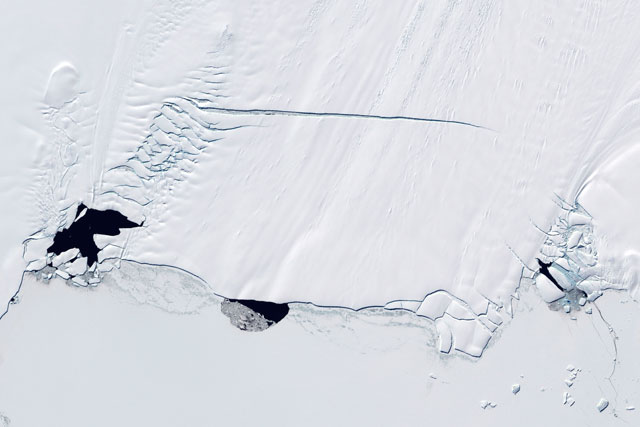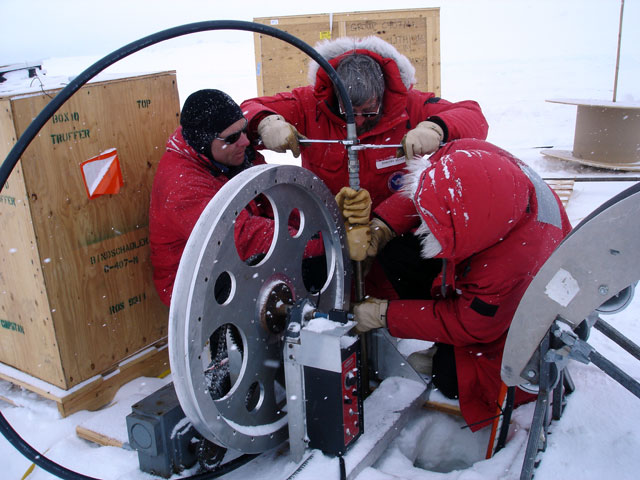|
Page 3/3 - Posted December 23, 2011
Peaks and valleysFinally, last year, BAS scientists flew a Twin Otter with their own radar instruments across parts of the ice shelf. The tight grid lines flown by pilots — called “mowing the lawn” — revealed that the bottom of the ice shelf isn’t being cleanly planed off by the warm water. Instead, the bottom more closely resembles corrugated steel, where channels have been carved. That ocean action affects not just the bottom of the ice shelf, but also the surface, Bindschadler explained. The channeling below creates an inverse effect on top, causing small ridges to form longitudinally between where two channels exist on the bottom of the ice shelf. Each surface ridge, heavily crevassed by the flexing, is next to a narrow valley that appears free of cracks. Mirroring each surface valley below the ice shelf is one of the channels carved by the warm water. 
Photo Credit: NASA
The Pine Island Glacier Ice Shelf, where the team will work about 15 kilometers south (up) from the crack that recently formed.
“It’s really nice that the one place where we can work, which is in the valleys, is sitting right over the top of where that meltwater is being concentrated by the topography of the bottom of the ice shelf,” Bindschadler said. “That’s the water we want to see. We get lucky. That’s where we can work and that’s where we want to work.” But it’s not a lot of room to work. Each valley is only a few hundred meters wide, but enough to establish the drill camp and all of the associated equipment, which must be moved by helicopter. The helos will also be used to ferry glaciologist Sridhar Anandakrishnan The researchers plan to install three profilers between this year and next. The instruments were developed by co-principal investigator Tim Stanton Each installation should take a about a week, Bindschadler said, based on a test run of the system two years ago near McMurdo Station on the nearby ice shelf. The team hopes it can deploy two profiler systems this year, but the ongoing transportation delays are jeopardizing that plan. “The hardest part we always knew would be getting out to PIG,” said Bindschadler, whose patience seems to be matched only by his desire to capture the data that he has been chasing for years. Time may be short for the expedition. But based on the rates of melting under way in parts of Antarctica and Greenland, the world may be running out of time before catastrophic sea-level rise begins. Many scientists now believe global oceans will likely rise by a meter by the end of the century — but the uncertainties are still too great to predict the future properly. “Melting ice holds the greatest possibility for change, and that’s why we’re interested in it,” Holland said. “Many cities around the world would be affected by sea-level change.” NSF-funded research in this story: Robert Bindschadler and Alberto Behar, Goddard Space Flight Center, Award No. 0732906 |



For USAP Participants |
For The Public |
For Researchers and EducatorsContact UsU.S. National Science FoundationOffice of Polar Programs Geosciences Directorate 2415 Eisenhower Avenue, Suite W7100 Alexandria, VA 22314 Sign up for the NSF Office of Polar Programs newsletter and events. Feedback Form |


